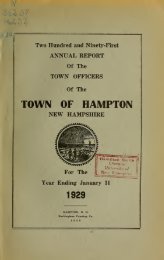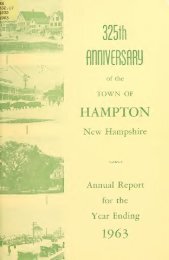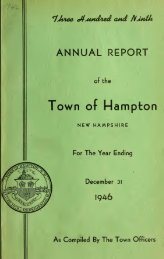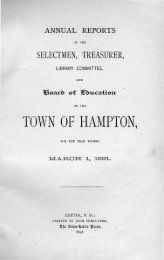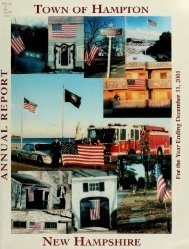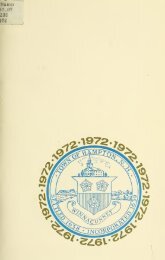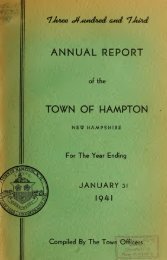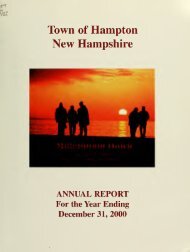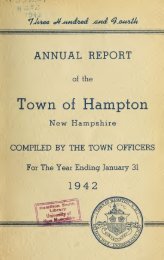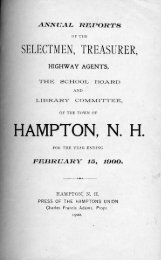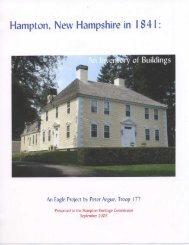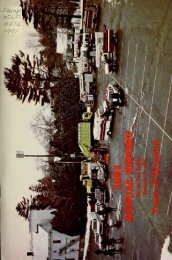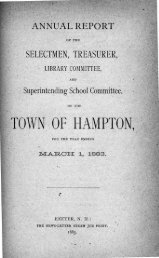Town of Hampton - Lane Memorial Library
Town of Hampton - Lane Memorial Library
Town of Hampton - Lane Memorial Library
Create successful ePaper yourself
Turn your PDF publications into a flip-book with our unique Google optimized e-Paper software.
To insure that the rate <strong>of</strong> growth <strong>of</strong> the <strong>Town</strong> does not unreasonably interfere with the <strong>Town</strong>’s capacity<br />
for planned, orderly, and sensible expansion <strong>of</strong> its’ services to accommodate such growth;<br />
To promote development harmonious with land capabilities within the <strong>Town</strong>;<br />
To prevent too rapid a pace <strong>of</strong> growth that tends to thwart the planning process and to escalate too rapidly<br />
the growth and costs <strong>of</strong> Municipal Services, especially <strong>of</strong> the Schools;<br />
To allow the shared growth goals, plans, and objectives <strong>of</strong> the <strong>Town</strong>, its’ Planning Officials and the<br />
residents to be realized in a comprehensive fashion as set forth in the <strong>Hampton</strong> Master Plan;<br />
This Growth Ordinance should also provide a mechanism when Municipal Services are strained or<br />
overloaded to reduce the rate <strong>of</strong> residential growth to allow the <strong>Town</strong> time to correct any deficiencies that<br />
have developed.<br />
I. Authority and Purpose<br />
This Growth Management Ordinance is enacted pursuant to the authority granted by NH RSA’s 674:21,<br />
674:22, and 674:23. It is intended to regulate and control the timing <strong>of</strong> development in accordance with<br />
the objectives <strong>of</strong> both the Master Plan and the Capital Improvements Program adopted by the <strong>Hampton</strong><br />
Planning Board. These two documents assess and balance the community development needs <strong>of</strong> <strong>Town</strong> <strong>of</strong><br />
<strong>Hampton</strong> and consider regional development needs. The Interim Growth Management Ordinance is<br />
intended to promote the orderly development <strong>of</strong> land within the <strong>Town</strong> <strong>of</strong> <strong>Hampton</strong> and also to promote<br />
the Public Health, Safety, and Welfare <strong>of</strong> the residents in the <strong>Town</strong> <strong>of</strong> <strong>Hampton</strong>. The continual increases<br />
to local Property Taxes has put an inordinate strain on our citizens, many <strong>of</strong> whom are elderly and on a<br />
fixed income and/or are considered low to moderate income wage earners. This raises serious questions<br />
about whether the existing Master Plan, Capital Improvement Program and Zoning Ordinance adequately<br />
reflect the Planning Board and Community’s expectations for logical and desirable development for this<br />
Community.<br />
The <strong>Town</strong> <strong>of</strong> <strong>Hampton</strong> Planning Board seems to be burdened with the responsibilities <strong>of</strong> Subdivision and<br />
Site Plan review that it has not had the time or resources to adequately take up and study these issues and<br />
concerns.<br />
II. Land Use Section<br />
A Land Use section should be developed that translates the vision statements into physical terms. Based<br />
on a study <strong>of</strong> population, economic activity and natural, historic and cultural resources, it shall show<br />
existing conditions and the proposed location, extent and intensity <strong>of</strong> future land use as required by NH<br />
RSA 674:2.<br />
Specifically the Planning Board makes the following FINDINGS OF FACT:<br />
• The ability <strong>of</strong> the existing municipal roadway network is inadequate to handle increased roadway<br />
traffic without a plan for upgrading these roadways;<br />
• Over-development is causing the fragmentation <strong>of</strong> Wildlife habitats and the existing Master Plan<br />
doe not inventory with sufficient detail and prioritize those remaining undeveloped areas <strong>of</strong> land based<br />
upon their Environmental characteristics and sensitivity and designate areas based on such priorities for<br />
Conservation Preservation.<br />
III. Annual Building Permit Limitation<br />
A. The number <strong>of</strong> building permits issued in a calendar year for new residential dwelling unit is limited<br />
to an amount that is 2.0% <strong>of</strong> total dwelling units in the <strong>Town</strong> <strong>of</strong> <strong>Hampton</strong> as <strong>of</strong> December 31 <strong>of</strong> the prior<br />
year.<br />
B. For the purpose <strong>of</strong> the ordinance the December 31 base <strong>of</strong> dwelling units shall be determined from the<br />
2000 US Census, updated with annual building permit data reported to the New Hampshire Office <strong>of</strong><br />
State Planning.<br />
IV. Equitable Distribution <strong>of</strong> Building Permits<br />
A. The town shall issue building permits for new dwellings on a “first come-first serve” basis.<br />
18



